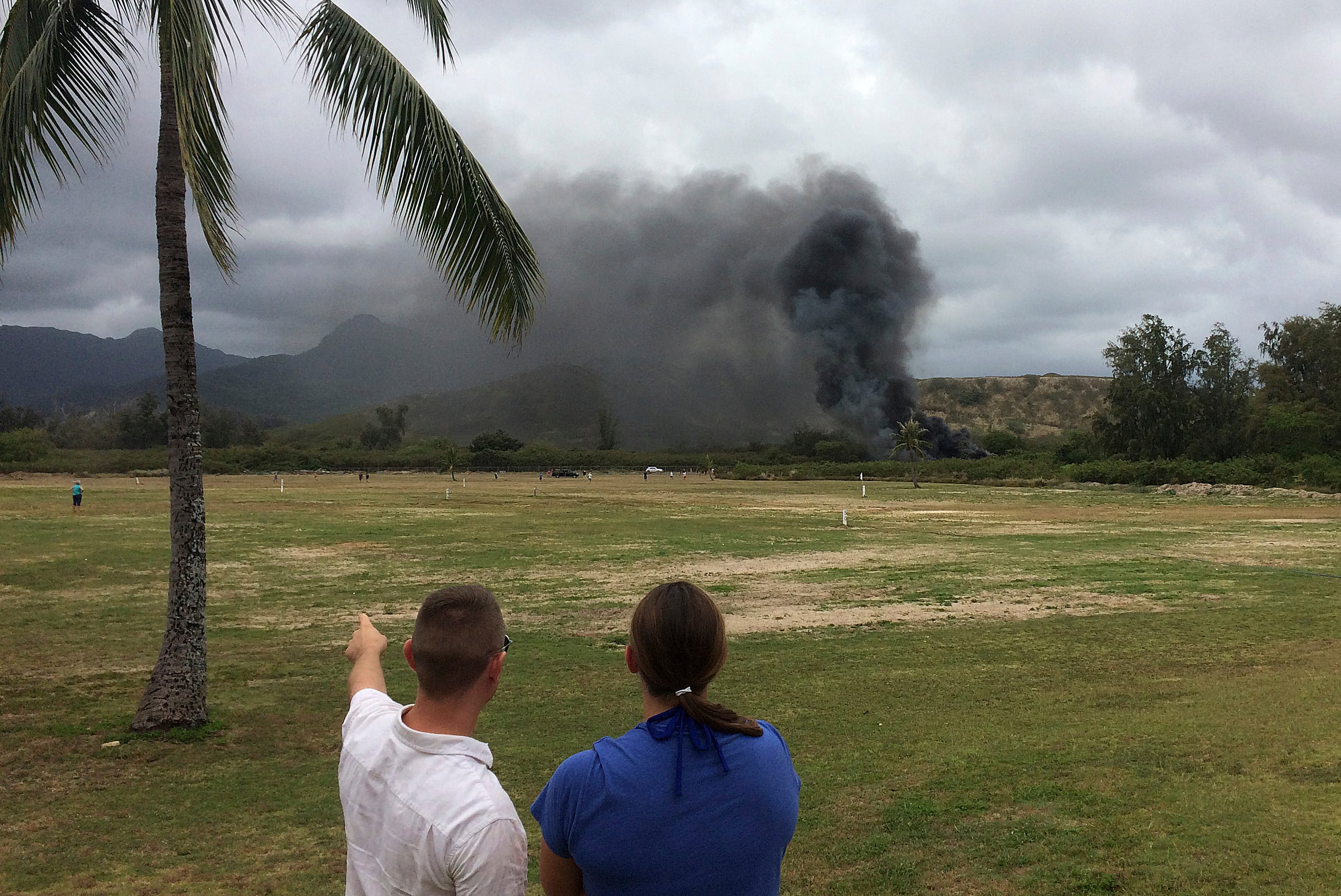Marine Corps officials have determined that decisions made by pilots in low-visibility conditions contributed to a May MV-22B Osprey crash in Hawaii that left two dead and 20 more injured.
A monthslong investigation into the May 17 crash at Marine Corps Training Area Bellows found that pilot performance and an improper survey of a landing zone were the main factors that led to the fatal accident, according to a Marine news release about the investigation.
While the report stopped short of finding the pilots in violation of regulations or flight standards, it said also states that "the investigation recommendations ... include the potential for disciplinary and administrative actions." Ultimately, the release said, the accident could have been prevented had the pilots made different decisions.
When the pilots made the first attempt to land the aircraft, visibility was much poorer than anticipated due to high levels of sand or dust in the landing zone area air.
"A proper risk assessment should have prompted the pilots to choose an alternate flight profile, path or landing site that would have minimized or avoided the severe brownout conditions," the release read.
The Marines continued to attempt to land the aircraft despite the high levels of debris in the area. Changes to naval aviation procedures as a result of the crash now recommend that pilots landing in similar conditions hover for no more than 35 seconds in order to prevent debris from getting sucked into the engines.
"Repeated, sustained flight time in brownout conditions ... while attempting to land caused the left engine to stall, resulting in a loss of power that placed the aircraft in an unavoidable freefall to the ground," according to the release.
When the tiltrotor aircraft, which can take off and land like a helicopter but fly like an airplane, entered into a low-altitude hover, both engines began losing. As the Osprey hovered, it kicked up a cloud of sand and dust. As the debris flew about the aircraft, the buildup of material in the aircraft caused the left engine to stall, the release said.
That led to decreased lift, which caused the crashhard landing.

Smoke rises from a Marine Corps Osprey aircraft that crashed May 17 in Hawaii. When the pilots made the first attempt to land the aircraft, visibility was poorer than anticipated due to high levels of sand or dust in the air.
Photo Credit: Zane Dulin via AP
Around that time, a fire broke out on the aircraft. The release does not specify whether the fire contributed to caused the crash or broke out after.
There were 22 members — including 21 Marines and one sailor — of the 15th Marine Expeditionary Unit aboard the aircraft at the time of the crash. Lance Cpl. Joshua E. Barron, a 24-year-old tiltrotor crew chief assigned to Marine Medium Tiltrotor Squadron 161 (Reinforced), died immediately following the crash. Lance Cpl. Matthew J. Determan, a 21-year-old infantry rifleman with 3rd Battalion, 1st Marines, died as a result of his injuries two days later.
The MEU was conducting a training exercise ahead of a seven-month deployment to Asia and the Middle East.
The Osprey crew was found to have responded appropriately to the engine failure. Investigators concluded that the crash "did not occur due to any misconduct or negligence of duties or training on the part of the air crew."
Investigators made several recommendations as a direct result of the mishap, the release said. One interim change was made to the Naval Air Training and Operating Procedures Standardization on Nov. 17 in order to help prevent similar mishaps, said 1st Lt. Sarah Burns, a spokeswoman for Marine Corps Aviation.
If a pilot is landing in a zone that has high concentrations of sand, prolonged exposure to the debris can result in reduced engine power, rapid power loss, engine surge or engine failure with uncontrolled rate of descent, Burns said.
"The recommended exposure time in Reduced Visibility Landing Profiles has been decreased from 60 to 35 seconds or less," she said.
The Marine Corps is working to enact changes tied to several other recommendations in the report, Burns said, including:
- Displaying engine performance and stall margins on the Osprey's multi-functional display.
- Advisories alerting pilots when engine power falls below 95 percent.
- More advanced brownout technology, including improved engine air filtration systems for the Osprey.
Burns said several different options are being reviewed to better filter air on the V-22 following the crash. The Bell Boeing V-22 team is developing an engine inlet barrier filter, which would replace the existing engine air-particle separator with a bypass door and oiled cottonlike filter in front of the engine inlet, she said.
The Marine Corps is working toward enacting some of the additional recommendations, Burns said.
Marine officials credited the "selfless actions of the Marines and sailor aboard the aircraft" at the time of the crash, along with the quick lifesaving actions of civilian and military first responders with helping prevent further loss of life. Barron and Determan were mourned throughout the entire Marine Corps, the release said:
"The loss of life was tragic and felt deeply in the Marine Corps community; our thoughts go out to the families of all those affected by this incident."





